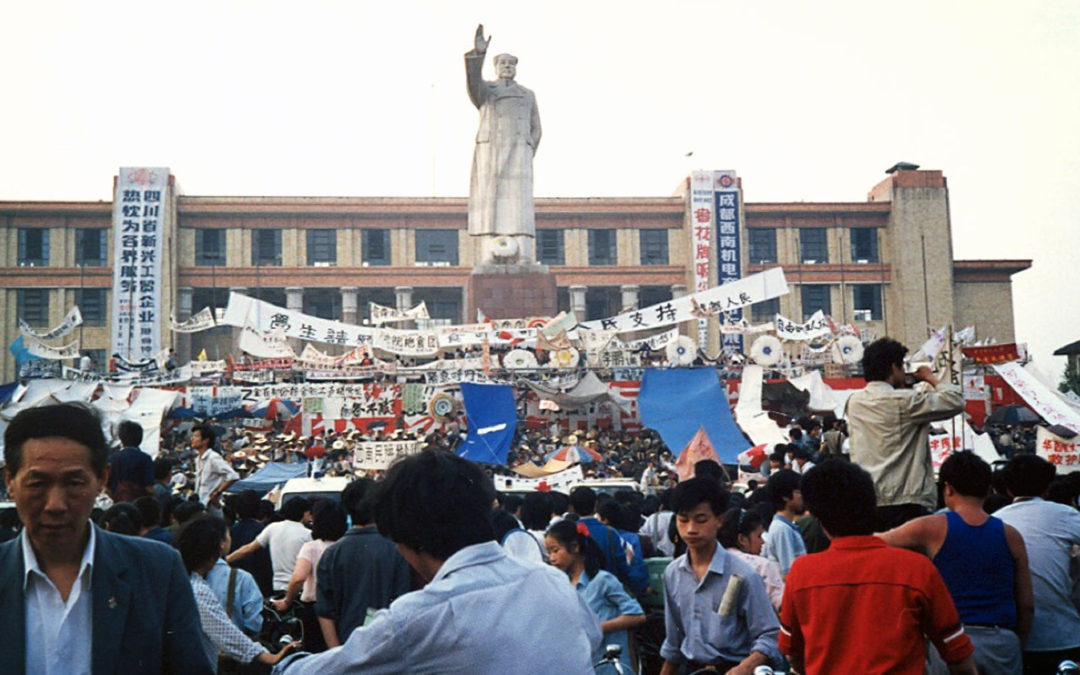Image via Louisa Lim/NPR.
“Around Tianfu Square, buses were burning, fire was set to police cars as well. The riots in Chengdu, you don’t know about that?” I was puzzled when, about two months ago, a cab driver started talking to me about the protests in Chengdu in 1989, in a tone that was clearly sympathetic to the uprising. The spring of 1989 still is a topic that would hardly ever be mentioned in discussions about politics and history, even with my closest friends here in the capital of Sichuan province, some of whom have relatives or teachers who have taken part in the demonstrations.
In reporting on and remembering 1989, international media coverage has almost exclusively been focused on the events in Beijing. Despite eyewitness reports and some academic publications, it is therefore easily overlooked that what happened 27 years ago was actually a nationwide social movement, with “massive protests […] engulfing cities and towns across China” (Unger 1991) – up to 63 according to some sources, from Urumqi in far West to Changchun in the Northeast and Guangzhou in the South. And, as the cab driver pointed out to me, some of the most violent clashes occurred in Chengdu.
Protest marches in the city of Chengdu began to take place by April 21, with students starting to occupy the central Tianfu Square. By May 16, after police forces had tried to disperse the crowds forcefully, “several hundred thousand people took to the streets immediately” (Lim 2014). “Protest became so commonplace that in certain circles, the standard greeting, ‘Have you eaten yet?’ was sometimes half-jokingly replaced by, ‘Have you demonstrated yet?'” This first phase of demonstrations in Chengdu lost its momentum after martial law was imposed in Beijing, however. When the police cleared the last remaining protesters from Tianfu Square in the morning of June 4, this went ahead more or less peacefully.
Things started to change within a couple of hours that same day. As soon as information on the crackdown and killings in Beijing had reached the city, “thousands of enraged citizens returned to the streets of Chengdu” (Lim 2014). The protesters showed their solidarity with the victims in the country’s capital, holding banners saying “We are not afraid of death” and “Down with the government of dictators.” When they were attacked by the paramilitary police, riots ensued. Again according to Lim (2014), people fought back by throwing “shoes, bricks, ripped-up pieces of sidewalk, and anything else they could grab.” Some started to set fire “to anything belonging to the state,” including a police station and a state-owned market. The unrest continued until the night of June 5 – and was met with ever more killings by the repressive state forces. According to some estimates, “from 300 to 400 people had been killed and upward of 1,000 wounded” (Hutterer 1989). As in Beijing, it was protesting workers and peasants who were most heavily hit by state retaliation in the aftermath of the unrest.
Today in Chengdu, the increased numbers of police cars on public squares and in front of university gates are a reminder that repression related to these events 27 years ago is still ongoing. But despite surveillance, censorship and the state’s attempts to rewrite history, conversations like the one with the cab driver demonstrate that the social movement of 1989 has not been completely erased from public memory.
For more detailed accounts of the 1989 protests in Chengdu and beyond, see:
Lim, Louisa (2014): The People’s Republic of Amnesia. Tiananmen Revisited. New York: Oxford University Press (Chapter 8 “Chengdu,” 182-205)
Unger, Jonathan (ed.) (1991): The Pro-Democracy Protests in China. Reports from the Provinces. New York: M.E. Sharpe.
Hutterer, Karl (1989): “Chengdu Had Its Own Tiananmen Massacre,” New York Times, June 23, 1989, http://www.nytimes.com/1989/06/23/opinion/l-chengdu-had-its-own-tiananmen-massacre-223689.html.
—ZGL



Chinese translation here:
八九六五:成都民眾憤怒的暴動
https://wknews.org/node/1118
I want to follow up on workers activities against the regime in China….please keep in touch….